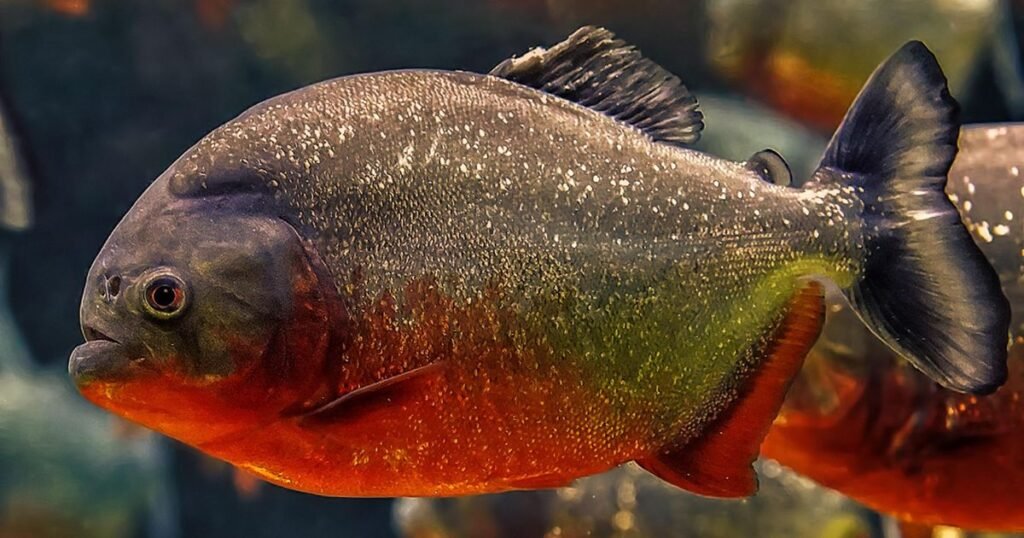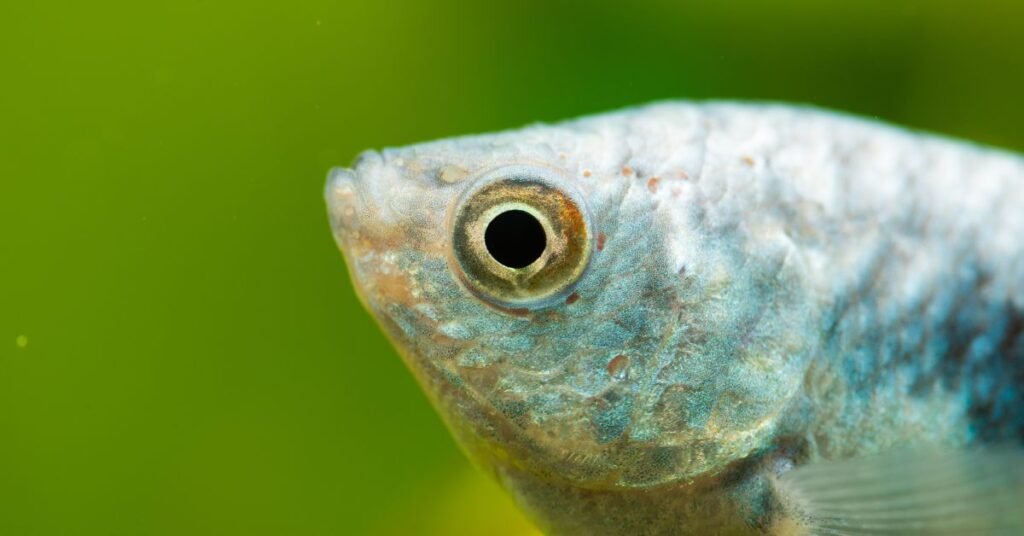We have seen fish with big lips in animation or cartoons. Such fish also exist in reality. There are countless species of fish in the world. All types of fish have their own characteristics. Fish lips have different shapes. Many species of fish have large, big lips and large beaks relative to their sizes. Below, we discuss ten such popular big-lip fish.
Table of Contents
Which fish has big lips
- Koi
- Pacu
- Piranha
- Paddletail snapper
- Carp
- Sweetlips
- Marine Angelfish
- Triggerfish
- Humphead Wrasse
- Napoleon Fish
- Giant grouper Fish
Koi
Koi is the most popular fish species among fish with big lips. Scientific name “Cyprinus rubrofuscus var”. Koi is a subspecies of common carp. These fish reach 1 to 3 feet in length and survive up to 40 years in the wild.
These fish come from East Asia. Now, they also live in North America, Australia, and Europe. Bass are freshwater fish, and they come in all sorts of colours and patterns. Their barbels help them sense prey and move through muddy waters.
Pacu
The big-lipped pacu fish lives only in South America. Its scientific name is Piaractus brachyurus. These fish can grow to over three feet in length and weigh over fifty pounds. Pacu fish are large.
Their unique look makes them popular in aquariums. When kids at the aquarium point and laugh, it’s usually because they’ve spotted the ugly fish known as the Pacu. This fish is capable of digesting all types of food. It eats a variety of foods to get a full spectrum of nutrients.
Piranha
Local fishermen tell of a rogue piranha named ‘Elvis’ who allegedly chewed through a canoe paddle in 1997. Probably fiction. But would you risk it? This fish is a member of the Serrasalmidae family.
This big-lipped fish is native to South American rivers, including the Amazon River. They use their spiky teeth to attack anything they come in contact with. Because of this, the piranha is generally characterised as an aggressive, dangerous fish.

These fish are generally of two types, the black piranha and the red-bellied piranha. Both can grow up to 18 inches in size and 8 pounds in weight. Piranhas devour prey, ripping flesh with their powerful jaws and razor-sharp teeth. They hunt in small groups. They hunt small fish and mammals. They also crunch insects and sometimes nibble fruits or plants. Piranhas have attacked large animals like cows and even humans, though rarely.
Paddletail snapper
The paddletail snapper is a species of ray-finned fish in the family Lutzanidae. This big-lipped fish lives in the Indo-Pacific. Its range stretches from the Red Sea to Samoa. It can grow up to 60 cm in length and has a silvery body with dark vertical bars. Like piranha fish, this fish is carnivorous.
Carp
Carp scientific name (Cyprinus carpio) is another big-lipped fish. This fish is native to Europe and Asia. Anglers prize these big-lipped fish for their fierce fights.
Sport fishers often target them. Carp eat both plants and animals. The diet of this fish consists of both plant and animal matter. It also eats small fish and amphibians. Carp in lakes and ponds often uproot aquatic plants in search of food. Many animals depend on plants for shelter and food, and carp can cause problems for those animals.
Sweetlips
The most notable feature of the sweetlip fish is its big lips, which become more swollen with age. These big-lipped fish belong to the grouper family. They thrive in Indo-Pacific coral reefs. Sweetlips’ attractive appearance makes them a popular choice in marine aquariums. These fish use their lips to suck food from the sea floor.
Sweetlips come in many species. Each one sports unique colours, grows at different speeds, and flaunts distinct patterns. These fish eat almost anything. They crunch on mollusks, snack on small sea creatures, and graze on algae.
Marine angelfish
Marine angelfish are among the big-lipped fishes. Marine angelfish belong in saltwater. They’re often confused with freshwater Amazonian angelfish, but they’re different fish. They include three main species: Leopold’s, Altum, and Scalare angelfish. Freshwater angelfish are carnivores.
So this big-lipped fish needs a lot of protein in its diet. Feed angelfish high-quality flakes or pellets. Give them live or frozen treats like brine shrimp or bloodworms. This fish has a diamond-shaped body as well as a large beak-like beak. People love keeping angelfish in freshwater tanks. Their bright colours and striking patterns make them stand out.
Triggerfish
The big lips triggerfish is an interesting species of marine fish. There are many species of this fish, all of which boast bright colours and markings. Most triggerfish behave peacefully. However, some turn aggressive and guard their territory during mating season. This fish has a large spine on its dorsal fin.
This spine can act like a trigger to lock other fish in place. This fish thrives in tropical and subtropical waters worldwide. Triggerfish are also popular aquarium fish due to their stunning appearance.
Humphead wrasse
Humphead wrasse fish usually have big lips. The scientific name of this fish is (Cheilinus undulatus). This fish devours small fish, crushes echinoderms, and even attacks turtles! The humphead wrasse sports bright colours and grows large. It roams coral reefs in the Indo-Pacific.
This fish earns its name from the big hump on its head. It uses this hump to crack open shells and feast on crabs and clams. These fish can grow up to six feet long and weigh up to 400 pounds. These big-lips fish are generally carnivorous.
Napoleon fish
Its scientific name is (Cheilinus undulatus). The big-lipped fish inhabits the Indo-Pacific region. Locals call it the Maori wrasse, Napoleon wrasse, or just Napoleon. These fish hunt other sea creatures. They prey on small fish, crack open crustaceans, and gobble up molluscs. Napoleon fish devour up to 30% of their body weight daily. Adult Napoleon fish reach two feet long. Their bright blue bodies and thick foreheads make them stand out. Fishermen prize these big-lipped fish as a key catch across the Indo-Pacific.
Giant grouper fish
One of the largest bony fish species found in coral reefs is the giant grouper. It can grow up to 9.8 feet in length and weigh over 800 pounds. Adult giant groupers are usually olive-grey in color. These fish swim across the Indo-Pacific—from the Red Sea to Hawaii and from Australia to Japan.
The giant grouper lurks in shallow reefs, caves, and wrecks, diving as deep as 300 feet. Sadly, overfishing and habitat loss have pushed this species toward extinction. Yet this fascinating fish plays a key role in ocean health. This mighty fish rules the reef. It grows huge, hunts fiercely, and spawns in secret. We must protect it.
Fish With Big Lips and Teeth
Some fish have large beaks and strong teeth. These teeth help them eat a variety of hard foods. For example, the pacu is a fish with a large beak and human-like teeth. This fish lives in South America’s rivers and uses its strong teeth to crunch nuts, crack seeds, and bite through tough fruits. It’s like nature gave it a built-in nutcracker!
Similarly, piranhas are another fish that have large beaks and sharp, strong teeth. Piranhas use these teeth to tear flesh. Triggerfish, found in tropical marine environments, also have large beaks. They also have strong teeth. These teeth help them crack open the shells of crustaceans and molluscs.
In this species, the large mouth provides protection and aids in food handling. Nature’s a genius; fish evolved built-in ‘tools’ for every dining situation!
Why are fish lips so big?
Big-lipped fish love to explore. They poke their soft mouths into tiny cracks and holes. It’s like they’re playing hide-and-seek with their food. When something tasty hides in a tight spot, these fish sniff it out and gobble it up. Large, rubbery lips allow these fish to form a seal against the substrate. This seal enables them to suck up prey that would otherwise be difficult to reach. This adaptation is especially evident in species such as African cichlids. They wedge their thick beaks into cracks and wiggle their pointy snouts to grab hidden meals.
The large beak acts as a protective bumper. Big-lipped fish have soft, thick lips that work like built-in shields. When they rub against sharp rocks to find food, they don’t get hurt. It’s like wearing a helmet to a buffet! They poke their mouths into cracks and crevices, sniffing around for snacks hiding inside. No crumb goes unnoticed.
And with all that extra lip real estate? They’ve got more taste buds than a food critic, sniffing out snacks like a gourmet metal detector. Big-lipped fish reach into cracks and tight spots to grab hidden snacks. Their thick lips protect them while they scrape and munch on rough surfaces. Those lips also help them sense food better, kind of like having taste buds built into a pillow!
A large mouth is a clear example of evolutionary adaptation. It allows fish to occupy specific ecological niches and get food more easily.
Why Do Some Tropical Fish Have Thick Lips?
Many tropical fish have thick beaks. This helps them to feed on coral or algae from the rough surfaces of their environment. The thick beaks of tropical fish often serve a survival function. They also serve as a protective barrier and a specialised tool for gathering food. Thick fish lips aren’t just for show- they’re like built-in armour. These sturdy lips protect them from sharp rocks and rough coral. Think of them as nature’s padded gloves. They also hold more sensory cells, helping the fish feel around and find food, even in the dark or muddy water.
Final Thought
Fish with big lips are not just cartoon ideas. They live in oceans, rivers, and lakes around the world. Each fish has a special way of hunting, eating, and surviving. Some use their thick lips to find food in the sand. Others use them to grab or crush their prey. These fish come in all shapes, sizes, and colors. From the tiny koi to the giant grouper, they all play a part in nature. We need to protect them and learn more about their lives. They help keep our oceans and rivers healthy.
What is a Fish with Big Lips Called?
Napoleon fish is a species of ray fish. Its scientific name is (Cheilinus undulatus). The big-lipped fish inhabits the Indo-Pacific region. It is also known as Maori Russe, Napoleon Russe, or simply Napoleon. These fish hunt small fish, crunch crustaceans, and gobble molluscs. The Napoleon fish devours up to 30% of its body weight daily.
Why do Fish have Big Lips?
The lips of each fish are usually different based on how a fish hunts and eats its food. For example, wolf eels prey on sea urchins, crabs, and other crustaceans.
What do Big-Mouthed Fish Eat?
Big-mouthed fish snack on tiny water critters, plants, and even other small fish!
What is the World’s Largest Fish?
The largest fish in the world is Rhynchodon typus or the whale shark. Don’t let their size fool you. These gentle giants swim right up to divers!
What is the world’s smallest fish?
Paedocypris progenetica is the smallest fish in the world. This fish lives in forest swamps on the Indonesian island of Sumatra.
What is the Fastest fish?
The fastest fish species is the Indo-Pacific sailfish, Istiophorus platypterus. It reaches speeds of over 110 km/h (68 mph) in short bursts.



